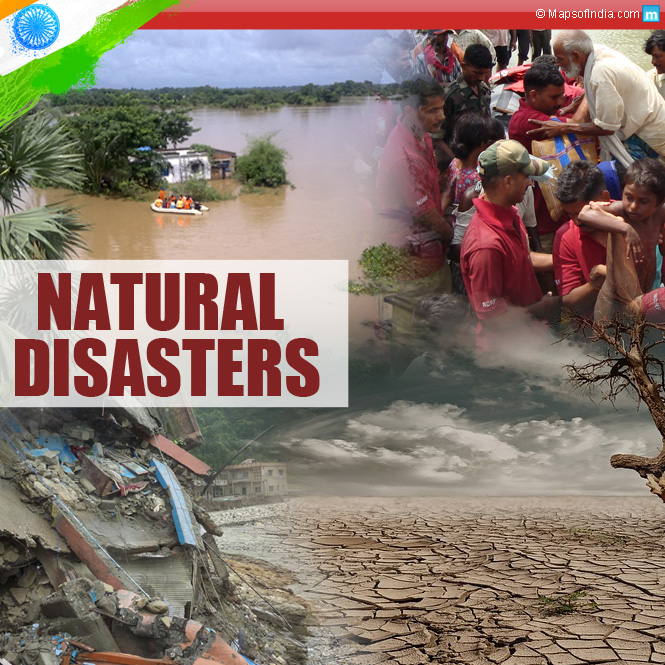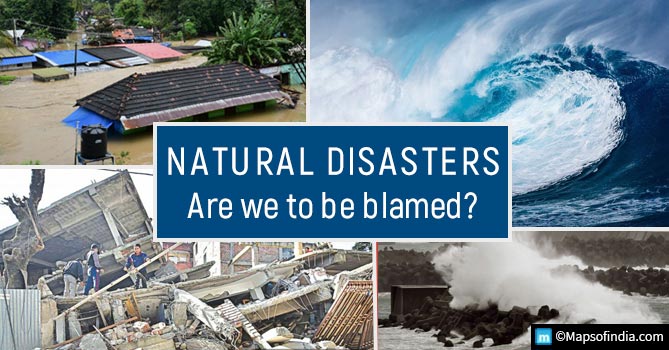Jammu and Kashmir is fighting one of the worst floods in history. Over 12 lakh people have been affected in Assam. It was just a year ago, the high ranges of Uttarakhand in the northern part of India were destroyed by flash floods, claiming the lives of thousands and thousands of people – tourists, pilgrims and the natives. There are many instances of such disasters happening in our country year after year.
The big question is when will India learn from its disasters? With every major disaster, we get to hear that the Centre has sanctioned a large amount of money to the affected State for relief and rehabilitation, as if aid is the solution! And soon after, a host of programmes and schemes and committees come into existence, squandering the money collected from the poor people of this country, perpetuating their poverty.
India has a history of natural disasters
India has been a victim of every kind of natural calamities be it floods, famines, droughts, earthquakes. The geographical location and climatic conditions of the country make it vulnerable to natural disasters. It is said that 60% of the earth is prone to earthquakes. More than 40 million hectares of land is prone to floods, 68% to drought and 8% to cyclones. How can we forget the Latur earthquake in 1993 or the Gujarat earthquake in 2001? We had the tsunamis in 2004 affecting South India and Andaman and Nicobar islands. In September 2013, around 40,000 people were evacuated and moved to safer places as a result of heavy floods in Gujarat. How can we forget Uttarakhand? Or more recently the Punjab floods and now the Kashmir floods.
These disasters have proved to be very dangerous for the country, affecting lives and properties and the economy as a whole. The history of past disasters has also made one thing clear that our country is still incompetent in handling catastrophes on a massive scale and hence it has always been affected by many calamities in the past and continuing even today.
We thought that India must have learnt its lessons from last year’s massive flash floods in Uttarakhand. But exactly after one year, there is the Kashmir floods, which the Prime Minister has declared as a “national disaster”. Other minor calamities are part and parcel of human lives. Natural disasters no doubt are “acts of God”. But then we cannot simply blame God and the geo-climatic conditions all the time.
Disaster management in India
Someone has rightly said, “India is a disaster when it comes to disasters”. When will India be able to handle disasters of massive proportions? It is to be noted that disaster management should occupy an important position in the country as it is the poor and the under-privileged people who are worst affected on account of natural disasters.
It is not that we do not have any disaster management system in India. The Disaster Management Act was passed in 2005. The Act provides for “the effective management of disasters and for matters connected therewith or incidental thereto.” Accordingly, we have the National Disaster Management Authority (NDMA), National Executive Committee(NEC), State Disaster Management Authority, National Disaster Response Force etc. There are many programmes to mitigate floods and droughts like the Drought Prone Area Programme (DPAP), Desert Development Programme (DDP), National Watershed Development Project for Rain-fed Areas (NWDPRA), Integrated Water Development Project (IWDP) which were introduced by the Planning Commission. A Department of Disaster Management (DDM) was set up in 2012 following enactment of the Disaster Management Act 2012.
Why India is a failure in tackling natural disasters?
Take for example, the flood alerts for Kashmir. The India Meteorology Department had stated that the rainfall of 308 mm as on September 3 increased to 558 mm rainfall on 6th September 2014, doubled within 3 days. This was a clear sign that with further rainfall, the situation can give rise to floods. In spite of this warning, the Central Water Commission (CWC) had made no forecasts of floods for the State. Had it been forecast earlier, which actually is the responsibility of CWC, steps could have been taken, instead of waiting for this calamity to take place and then taking steps.
Not only J&K, every other State in India is vulnerable to disaster risks, including Assam, Madhya Pradesh, Odisha, Uttar Pradesh and West Bengal, considering the large population and exposure to climatic hazards. Also, the level of disaster management, handling and preparedness in the States and at the Central level is uneven and it requires proper strengthening. Such hazards will only increase in the coming years. We also have other factors like poverty, population, rapid and uncontrolled urbanization, environment degradation, exploitation of natural resources, inefficient public policies and lack of infrastructural facilities which all together make the problem of handling disasters all the more difficult.
How to save ourselves from natural disasters?
Millions of people are affected every year in the country and the economic losses affect the Gross National Product (GNP). Every year, our county spends huge amount of resources for rescue, relief and rehabilitation works as a result of the consequences of the natural disasters. All the achievements till then is washed out.
Disaster management is actually a dynamic process, which involves planning, staffing, organizing, leading and controlling. It includes immediate response, prevention, mitigation, recovery, preparedness and it is a combined effort of all authorities, the States and the Centre.
The disaster management policies in the country give more emphasis on emergency responses and relief. But as we all know, always “Prevention is better than Cure.” More and more emphasis should be given on natural hazard prevention and mitigation. It is not possible to avoid disasters altogether. But the State governments can actually take measures to minimise the impact. It is better to study, analyse, assess the disaster potential of various areas which are prone to natural calamities and also find out ways to remedy the situation. And of course, we also need a much better flood forecasting, rainfall and drought prediction so that all kinds of disaster management plans, preparedness and mechanisms are functional, well in advance.






